Among the regions most receptive to marble inlay, seventeenth-eighteenth-century Apulia boasts a substantial number of examples, including church chapels, often of lay or confraternal patronage. Among the greatest examples of Neapolitan Baroque outside Naples is the Cappellone di San Cataldo in Taranto Cathedral, built to the left of the presbytery (fig. 1); together with the Chapel of the Blessed Sacrament, it has fortunately survived the restorations of the 1950s, aimed at the elimination of all the ’additions’ of the modern period. Marble cladding predominates in it from the floor to the walls, up to the drum of the dome, which, however, is frescoed. Slightly elliptical in plan, an architectural module very common in Baroque Rome, though mediated by some Neapolitan examples (church of San Sebastiano, later destroyed), the Cappellone di San Cataldo does not seem to have direct comparisons with similar chapels built in modern times in Neapolitan churches. It is accessed through a vestibule of quadrangular shape, originally a 16th-century chapel, and, as anticipated, the Cappellone remains unique in Apulia for the marble decoration that from the cornice on which the dome is set proceeds downward; on the two half-ellipses are distributed five niches that follow a decreasing trend, starting with the central one, larger than the others (fig. 2). At the point of agreement of the two half-ellipses, however, the most important niche was carved out to preserve the silver statue of Saint Cataldo.
The decision for such a construction was due to the Neapolitan Tommaso Caracciolo of the princes of Avellino, a Theatine and archbishop of Taranto since 1637; he, in order to restore the proper decorum to the cathedral, which had been devastated by a terrible fire on Christmas night of the previous year that reduced the organ and the roof to ashes, decided to repair the cathedral by showing greater attention to the chapels on either side of the presbytery area. In that of the Blessed Sacrament he had stucco decorations and paintings executed, as well as having a human-sized portrait of him in a prayerful, kneeling attitude inserted before the new altar, which features a tabernacle decorated with inlaid marble, an example that immediately brings to mind the one in sculpture of Oliviero Carafa in the succorpo of the cathedral of San Gennaro, executed by an anonymous sculptor in the early 16th century). According to the testimony of Cassanelli, who wrote the Life of St. Catal do in 1717, the Chapel of St. Cataldo under the archbishopric of Caracciolo was built in its essential lines, being still incomplete with its roof in 1663, the year of his death. Although there are no direct testimonies, it is likely to think, as has been reiterated on several occasions by Mimma Pasculli Ferrara, that its architect was Cosimo Fanzago (Clusone, 1591 - Naples, 1678), since the Cappellone appears as a “perfect synthesis of architecture, sculpture and pictorial decoration and a typical expression of that religious triumphalism inspiring much artistic production of the seventeenth century.” From a stylistic analysis with another admirable example of Neapolitan Baroque, the Cacace Chapel in San Lorenzo Maggiore, built in 1665 on commission from Neapolitan nobles, for which Fanzago received as much as 1885 ducats, the scholar identifies in the Taranto Cappellone a stylistic detail that seems to be the signature of the sculptor from Bergamo. In several panels is placed in the base and top a slightly raised lanceolate point, inlaid in turn on the inside, as well as another decorative element, the rose window of bardiglio, which if in the Cappellone di San Cataldo is repeated three times in theintrados of the entrance arch from the vestibule to the room proper, in the Carthusian monastery of San Martino in Naples it is a constant solution that Fanzago adopts on the entrances to the various chapels.
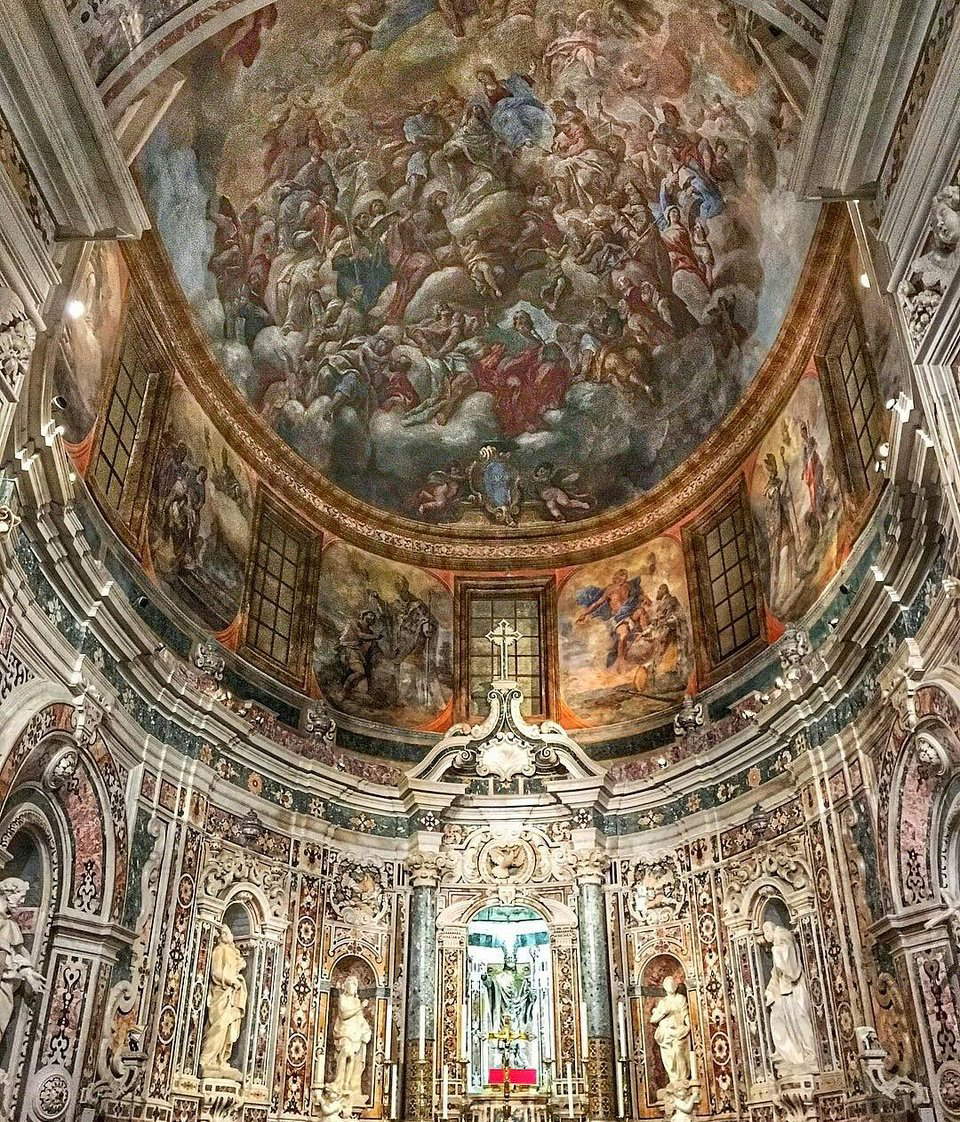 |
| 1. The large chapel of San Cataldo, Taranto Cathedral. |
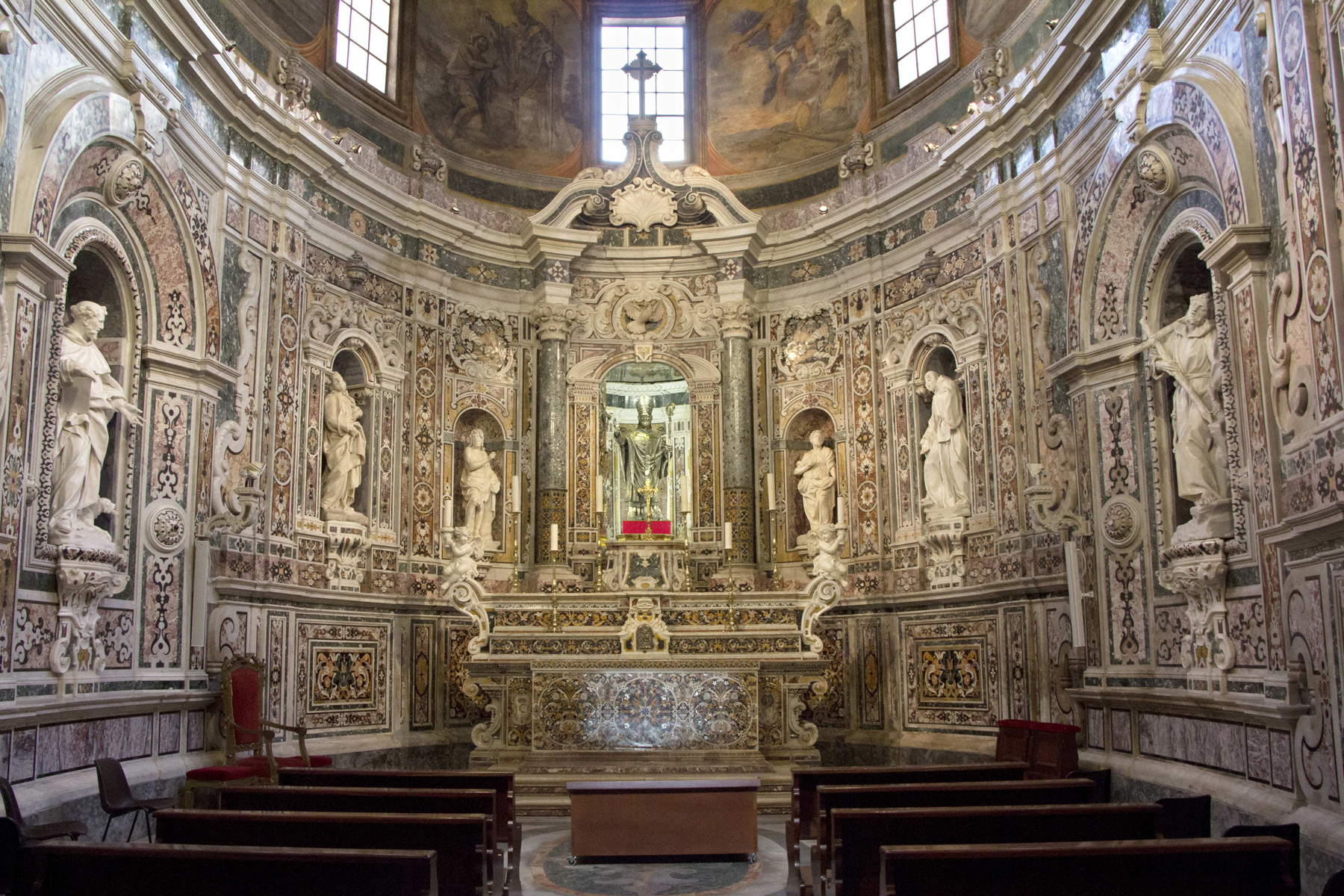 |
| 2. The Cappellone of San Cataldo, Taranto Cathedral. |
It must be thought, in fact, that Caracciolo, mindful of what was being accomplished in those years in Naples with the construction of the chapel of the Treasury in the cathedral, begun in 1608 and completed about four decades later, created archbishop of Taranto, wanted to have a Cappellone built in the Apulian city as well that would be worthy of the city’s patron saint, according to precise directives that would contribute to the constitution of a unified project. Given the size of the construction, however, the work went on for more than a century and saw the alternation of many artists, marmorari, and sculptors, who, from time to time, stuck to the initial project, as would seem to be confirmed by archival documents unearthed in recent times by Mimma Pasculli Ferrara and architect Gabriella Morciano. Giovanni Lombardelli, a marble worker from Carrara, for example, who was already present in Naples in 1637 among the members of the Guild of marble workers, was responsible for the construction of the high altar (fig. 3), as can be seen from a contract drawn up on May 10, 1676, from which we learn that he received a sum of 2,000 ducats for the altar that he was to build within two years. Truly remarkable is the report of the reuse of many ancient marbles, some from the church of San Domenico that abounded in different parts of the city, while to carry out the work Lombardelli called five other ’masters’ to Taranto. In the crypt of the same cathedral, moreover, as architect, Giovanni built the chapel of Santa Maria del Popolo commissioned by Bishop Caracciolo in 1651 and decorated only in patire from 1662; he, however, could never see it completed, having passed away, as we wrote, on January 15, 1663 (it was destroyed in 1844 by then Bishop Blundo). Returning to the altar of St. Cataldo, Lombardelli opts for a linear design, in which each part is characterized by a rich decoration with phytomorphic elements, from the antependium to the lateral ones up to the steps of the postegal, surmounted by two columns that frame the niche within which the’ancient silver statue of St. Cataldo; the two altar-headed putti, with the ciborium, were added during the archbishopric of Francesco Pignatelli, as evidenced by the presence of the coat of arms with three pine cones, the work, most likely, of Antonio Ragozzino.
There is a lack, at present, of information about the period from 1676 to 1695, the year in which Giovanni Lombardelli must likely have already been deceased because to direct the work in the Cappellone, in his place, took over from Antonio Ragozzino, who would work over the next four years in accordance with the original project, with the “same good and perfect mastria with all the arch and frontispiece of that.” Pasculli Ferrra, moreover, taking into account a dossier related to a lawsuit between Tommaso Algisi, who had a house adjoining the new construction, and the deputies of the Chapel of San Cataldo, Antonio Galliteli, Giacomo Marianna and Cataldo Antonio Cossetta, believes, correctly, that Lombardelli himself, in addition to the construction of the altar, proceeded to cover the walls of the Cappellone with committed marble.
It goes without saying that in 1676 if it was decided to furnish the Cappellone with the high altar it was because it was to appear finally complete, and therefore this date constitutes the terminus ante quem for the masonry covering, which had to be executed after 1663 and in any case under the archbishopric of the Dominican Tommaso di Sarria, who moved from the diocese of Trani on April 13, 1665, called to fill the see left vacant by the late Tommaso Caracciolo. In the minutes of a pastoral visitation held in 1671, the bishop still mentions the old chapel of San Cataldo, located to the left of the cathedral’s high altar and complemented by an altar dedicated to the saint; as will be examined, in the 18th century it was decided to transform it into the vestibule that today gives access to the current Cappellone, also covering its surfaces with marble.
As already anticipated, on April 13, 1695, Antonio Ragozzino, during the archbishopric of the Neapolitan Francesco Pignatelli, of the Dukes of Monteleone, entered into a contract with the deputies of the Chapel, by which he undertook to continue the work in the Cappellone according to the original design and to finish it within four years.
In 1713, after ten years of a vacant see, the new archbishop Giovan Battista Stella arrived in Taranto, who was responsible for commissioning the fresco decoration of the dome by Paolo De Matteis (Piano Vetrale, 1662 - Naples, 1728), who depicted the Glory of Saint Cataldo (fig. 4) and Episodes from his life between the windows of the drum of the dome, and the work on the covering of the vestibule or anticappella (the ancient chapel of St. Cataldo) by the Neapolitan marble worker Andrea Ghetti, which began in 1724 until 1729, the year of his death. The work, however, was not interrupted but continued by Nicola and Francesco Ghetti, Andrea’s brother and nephew respectively, under the episcopacy of Casimiro Rossi (1733-1738) and Giovanni Rossi (1738-1750) from 1736 to 1742, the year Nicola also died; Francis, therefore, unable to continue the work alone, proposed to the deputies of the Chapel the restitution of the ducats obtained for work that had not actually been done, and in 1742 the marble mason Aniello Gentile was called in to estimate the work completed by the Ghetti for 3010 ducats against the 3550 received. The same Aniello, moreover, was hired to make the floor, at least until 1753, when he turns out to be deceased and the deputies called in the surveyors Gennaro de Martino and Gennaro Cimafonte to assess the state of the work; unfortunately, the accounts of that survey have not come down to us, but according to the studies of Mimma Pasculli Ferrara, Gentile had to almost completely complete the floor decoration and the entire wall of the counterfacade, where the organ is currently located.
In 1750 the new archbishop, the Neapolitan Antonio Sarsale, took office and remained there until 1754, when he was transferred to Naples; in his place came the Montecassino Benedictine Isidoro Sanchez de Luna of the dukes of Arpino, who wanted to endow the Cappellone with 1,500 ducats for the creation of worship objects.
On December 31, 1771, Archbishop Francesco Saverio Mastrilli, who had been in Taranto since 1759, commissioned the Neapolitan marble mason Domenico Tucci, based on the design of Giuseppe Fulchignone, director of works on the Cappellone, to make the marble facade, which would be completed by the iron gate forged by master ironworker Rocco Imperato and covered in brass by master brassworker Pasquale Terrone, who collaborated with Tucci himself so that the result would be in harmony with the architecture.
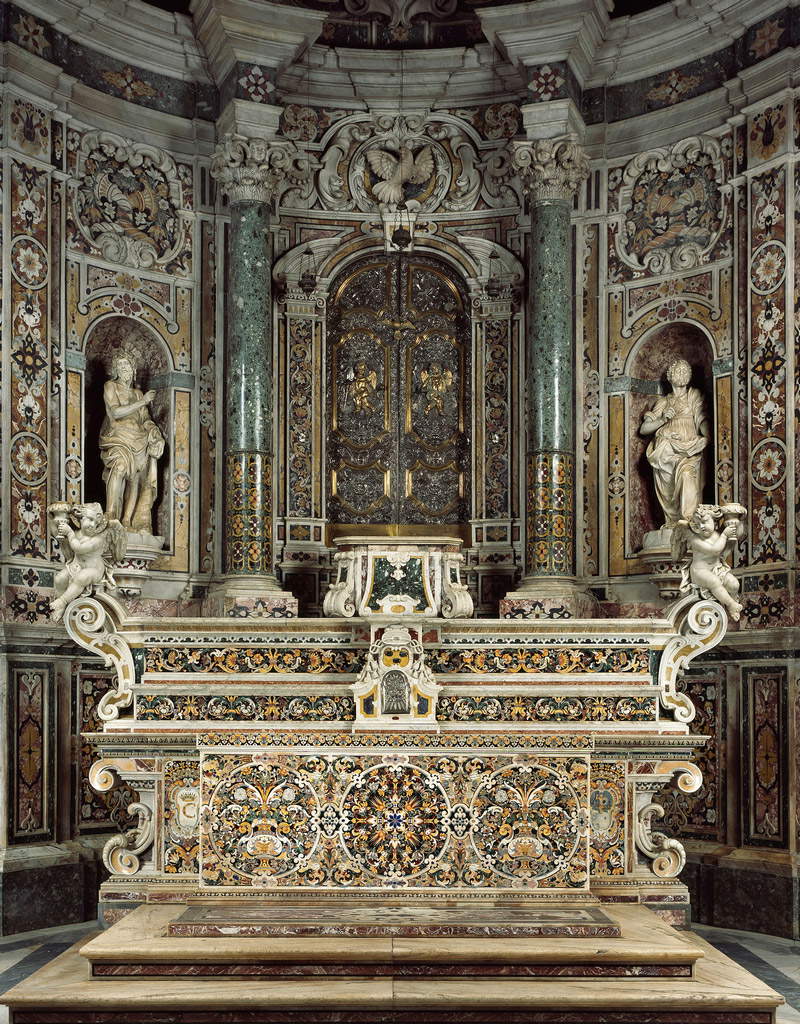 |
| 3. The high altar by Giovanni Lombardelli |
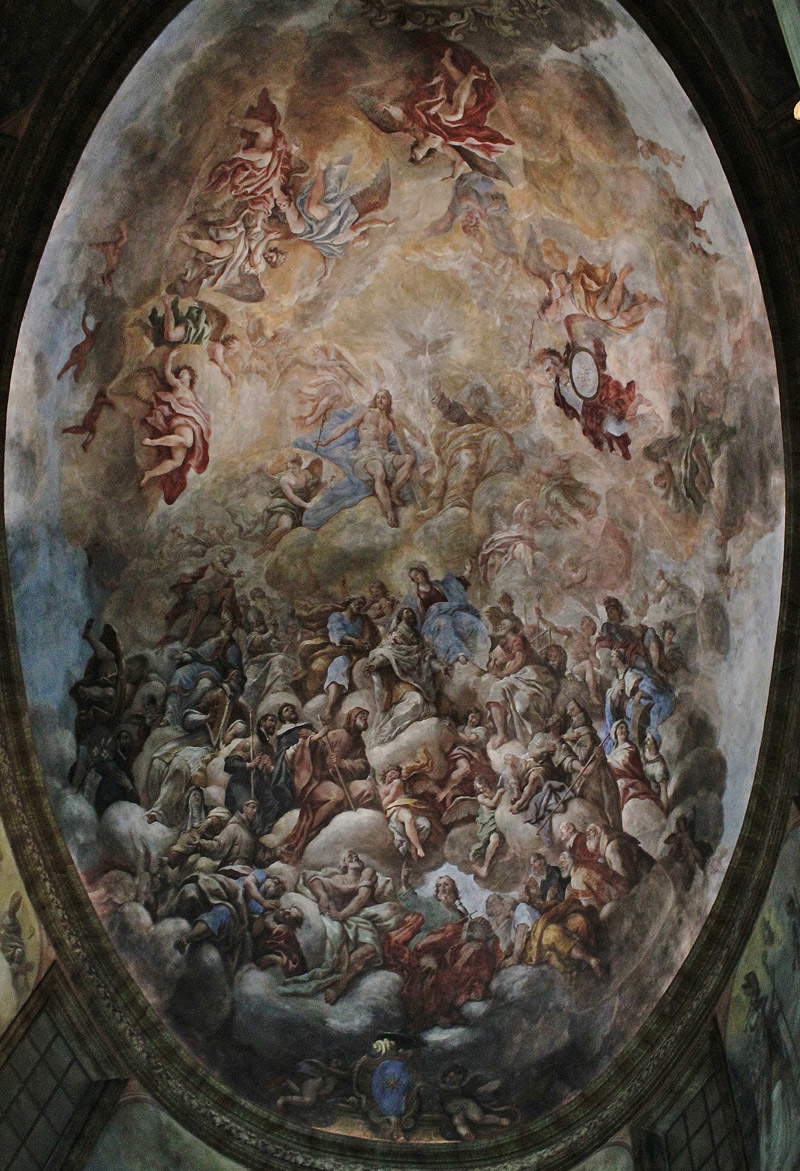 |
| 4. Paolo De Matteis, Glory of St. Cataldo |
Giuseppe Sanmartino in Taranto
Through archival data tracked down by Gabriella Marciano, it is known that these ducats were likely used to pay for the work of Giuseppe Sanmartino (Naples, 1720 - 1793), who in 1772 obtained 1,600 ducats for the creation of the statues of St. Dominic (fig. 5), St. Francis of Assisi (fig. 6), St.FilippoNeri (fig. 7), St. Francis of Paola (fig. 8) and St. Irene (fig. 9), obtaining three hundred ducats for the first two respectively because they were larger than the others, for which, on the other hand, he obtained 250 ducats for each. They were placed inside niches covered with mixed marble, and to create greater depth in them, engineer Giuseppe Fulchignone, still the director of works, opted for the creation of corbels on which the aforementioned statues rest, while as a reminder of the archiepiscopal bequest, he wanted to insert the coats of arms of Bishop Sanchez de Luna, when on the other hand, as previously written, on the Taranto cathedra sat since 1759 the Theatine Francesco Saverio Mastrilli, of the Marigliano family, remaining there until 1777.
After the great experience with Raimondodi Sangro, which led Sanmartino to the creation in 1753 of the famous Veiled Christ, consecrating him among the greatest sculptors of the 18th century, the Taranto experience was another great success. Giuseppe Sanmartino stipulated the contract in Naples on March 30, 1772, through Francesco Antonio Adamo, procurator of Bishop Mastrilli; the stipulation set the time for delivery by October 1773 and provided for the creation of two larger statues, of eight palms, St. Dominic and St. Francis of Assisi, to be placed in the central niches of the Cappellone, and the other four of seven palms, to be placed in the niches lateral to the central ones. According to the document, it seems that the desired arrangement was observed only in part, in that on the sides of the Assisian saint were to be arranged Saints Philip Neri and Francis of Paola, while on the sides of the Guzman saint were to be placed Saints Irene and Teresa (fig. 10); instead, on the sides of Saint Francis of Assisi are placed Saint Francis of Paola and Saint Irene, and on the sides of Saint Dominic, Saint Philip Neri and Saint Teresa. The sculptor also executed clay models to be submitted to the attention of Giuseppe Fulchignone and “some good painter” of whom the documents do not specify anything else; Elio Catello has identified two such sketches depicting saint Philip Neri, which compared to the final version has few variations concerning the paludamento, and saintFrancescod’Assisi at the Kunsthistorisches Museum in Vienna. The statues were sculpted directly in Naples, and Giuseppe Sanmartino was to bear the expenses of “transporting them to the navy of Naples,” while on the journey to Taranto the deputies of the Chapel of San Cataldo would provide.
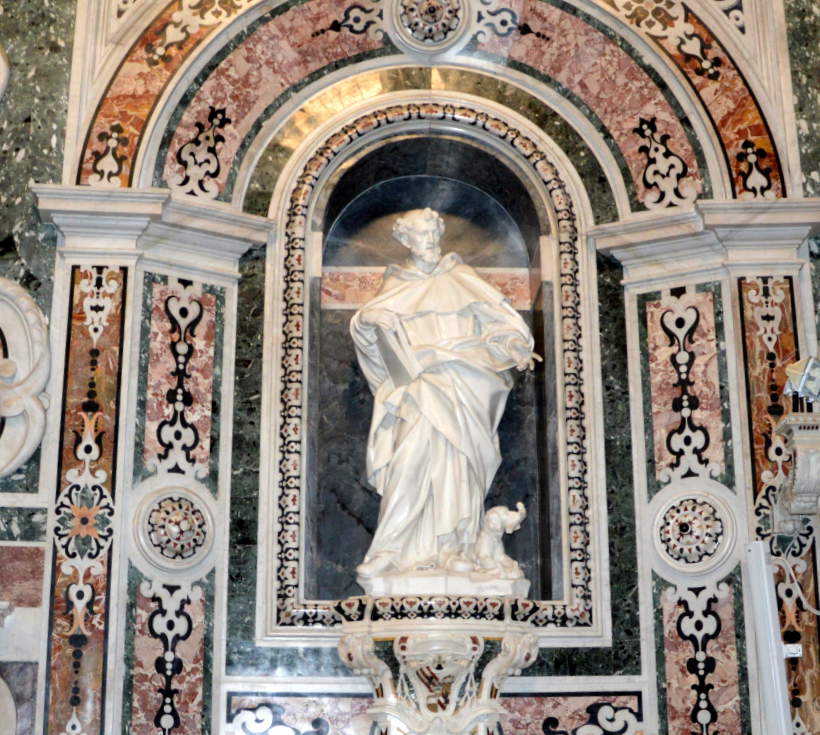 |
| 5. Giuseppe Sanmartino, San Domenico |
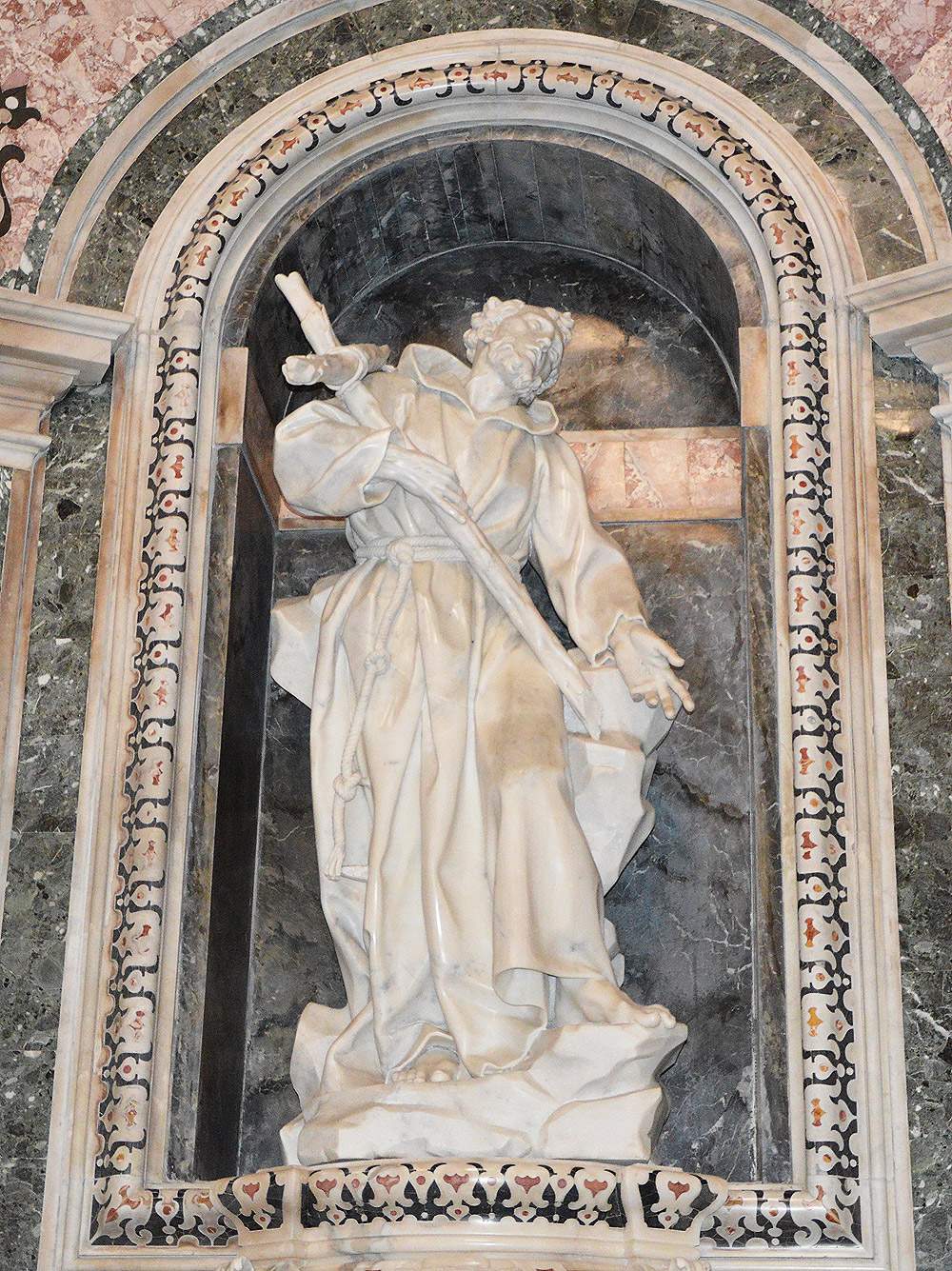 |
| 6. Giuseppe Sanmartino, Saint Francis of Assisi. Ph. Credit Churches on the Pilgrimage. |
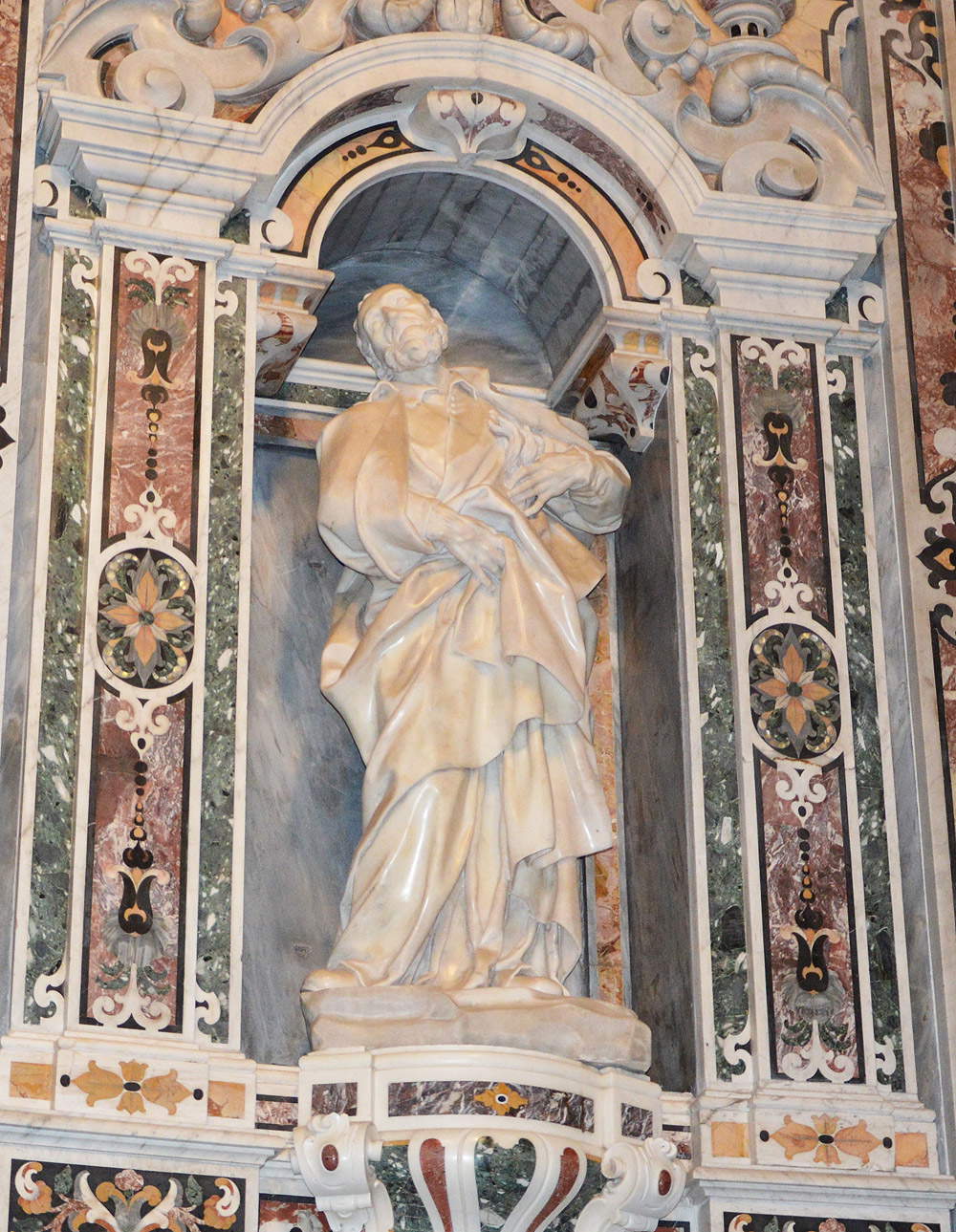 |
| 7. Giuseppe Sanmartino, Saint Philip Neri. Ph. Credit Churches on the Pilgrimage |
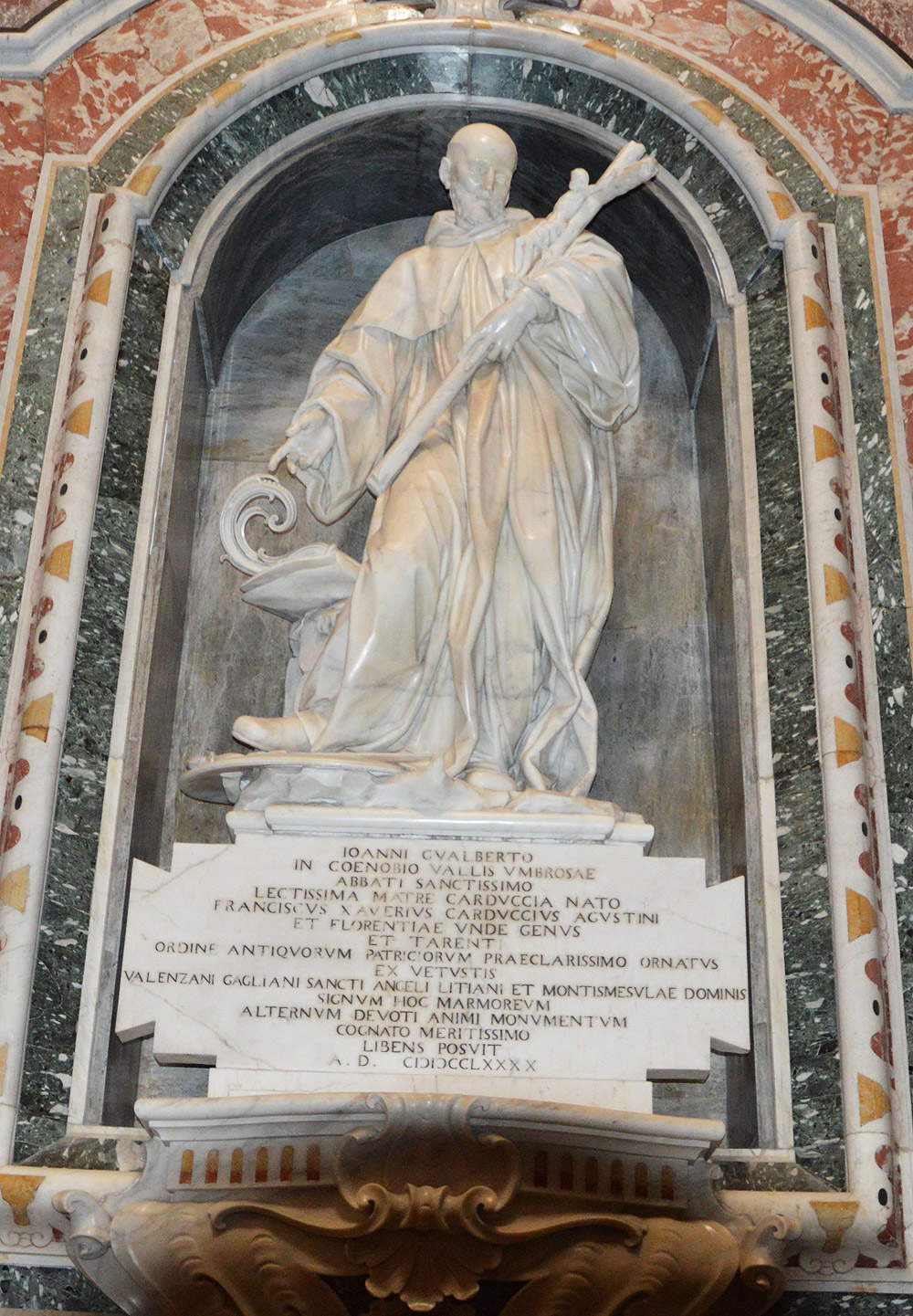 |
| 8. Giuseppe Sanmartino, Saint Francis of Paola. Ph. Credit Churches on the Pilgrimage |
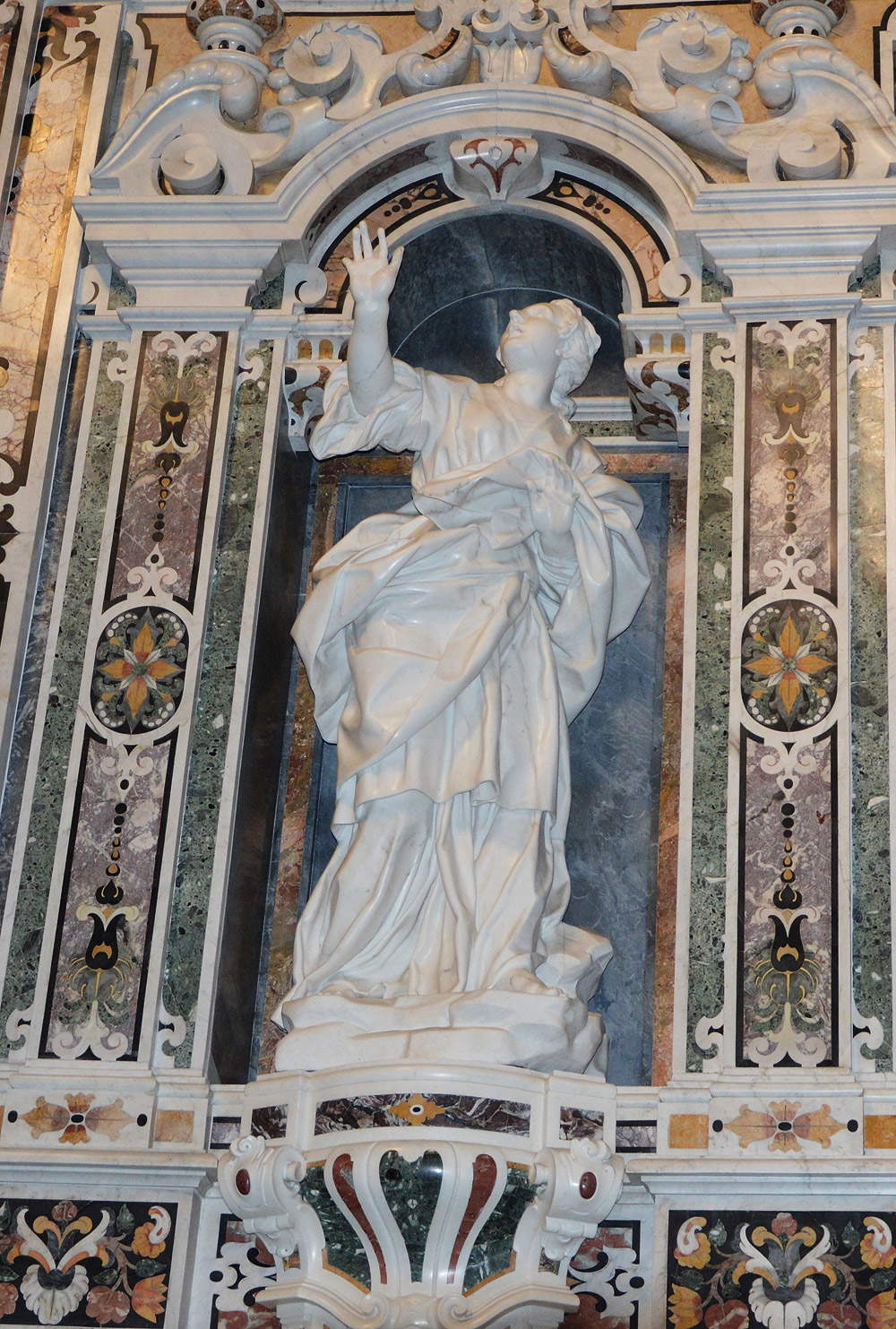 |
| 9. Giuseppe Sanmartino, Saint Irene. Ph. Credit Churches on Pilgrimage. |
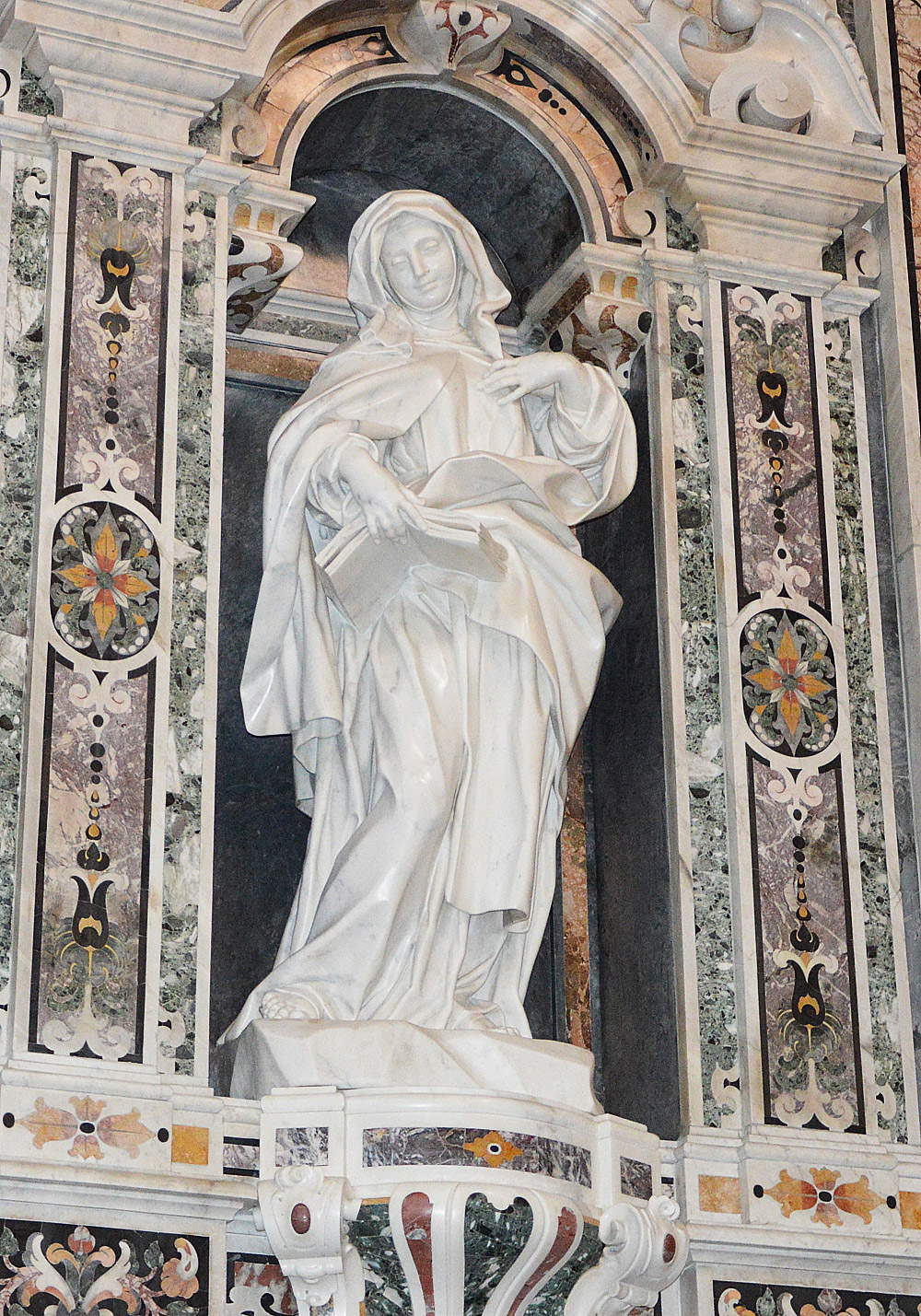 |
| 10. Joseph Sanmartino, Saint Theresa. Ph. Credit Churches on the Pilgrimage |
Iconographically, the Saint Francis of Assisi precedes a second version attributable between 1785 and 1788, preserved at the museum of San Martino in Naples, but coming from the church of Sant’Efremo Nuovo and intended to be placed on his tomb; for the execution of the Saint Dominic, however, the Vaccarian memory of the same saint for the spire of the same name in Naples must have been still vivid in Giuseppe Sanmartino’s mind. More Fanzagian appears to be the St. Francis of Paola, perhaps because at the same time the sculptor was finishing the statues of Saints Peter and Paul for the facade of the Gerolamini church in Naples, previously rough-hewn by Cosimo Fanzago; the saint is portrayed according to the usual iconography that wants him with his gaze rapt toward heaven, and the gesture of moving back his torso gives the sculpture a strong gestural quality, the same that distinguishes Saint Irene, for whom, however, Elio Catello seems to identify a strong collaboration by the sculptor’s pupils. St. Theresa is posed in “contrapposto,” as she carries her right leg forward, to which corresponds her left arm raised and bent to better emphasize the fineness of the elongated metacarpal of the hand brought toward her chest; her face, framed by the soggólo and veil, is characterized by a very sweet expression, dictated by a barely hinted smile, a solution that the sculptor experiments with, probably in the same turn of years, in two allegories in the cathedral of San Martino in Martina Franca, a town not far from Taranto. I allude to the Charity, in which the execution of the sculptural group is really high and where Sanmartino achieves extraordinary results in the foreshortened view of the figure, and in theAbundance, “a work that like few others encapsulates all the poetics of the master, together with a firm structure that highlights Bernini-like nostalgia.”
Returning to Taranto, with Giuseppe Sanmartino’s group of statues, the Chapel of San Cataldo was nearly completed in all its magnificence; on May 3, 1774, Archbishop Mastrilli entered into a contract with Filippo Beliazzi in Naples through his procurator Giovanni Leonardo Mascia; the latter, having already worked at the Carthusian monastery of San Martino, where he made the balustrade in 1761, was probably advised to the Taranto bishop by the same Sanmartino, who had worked on the chapels of San Martino and the Assumption four years earlier. Beliazzi undertook to execute the floor in front of the Cappellone di San Cataldo, in the center of which Mastrilli’s tombstone was placed. The munificent archbishop wished that the Chapel of the Blessed Sacrament could also be enriched with marbles, from the floor with red Venetian marble in the background with a central polylobed motif of black and yellow white tessellations to that of the right arm of the transept, also in colored marbles with a double star and semistar motif, from the door on the short wall of the transept, symmetrical and mirroring the one executed by Filippo Beliazzi in the arm opposite the altar with sculptors executed by Giuseppe Sanmartino.
In 1778 the new archbishop of Taranto, the Neapolitan Giuseppe Capecelatro, was elected, and in 1790 he again approached Giuseppe Sanmartino for the creation of a St . Joseph (fig. 11) to be inserted in the vestibule; the stipulation, which took place in Naples, bears the date of November 25 and was ratified in Taranto the following December 2. The sculptor would have executed the statue depicting the putative father of Jesus of the same height as the one of Saint John G ualbert recently made by the same for Don Saverio Carducci Agustino and placed probably since August 1789 in another niche in the vestibule. For the St. John Gualbert, of which a drawing still remains preserved by the Carducci family, Giuseppe Sanmartino obtained 660 ducats, while for the St. Joseph, “to be considered one of the highest autographs of the last production of the master” in which "a special attention to the pressing neoclassical instances, at that time in Naples particularly felt by a certain patronage 700 ducats, including also the model. These are, ultimately, some of Giuseppe Sanmartino’s last works, considering that he would die in 1793; almost two centuries after the first works, initiated almost certainly by Cosimo Fanzago, the Cappellone di San Cataldo was finally considered finished, with the exception of still four other vacant niches, which it was planned to fill with as many statues, those of St. John the Baptist (fig. 12) and St. Peter (fig. 13) attributed by Riccardo Naldi to the Renaissance sculptor Giovanni Nola, while those of St. Sebastian (fig. 14) and St. Mark were sculpted by the Neapolitan Giuseppe Pagano in 1804 for 453 ducats.
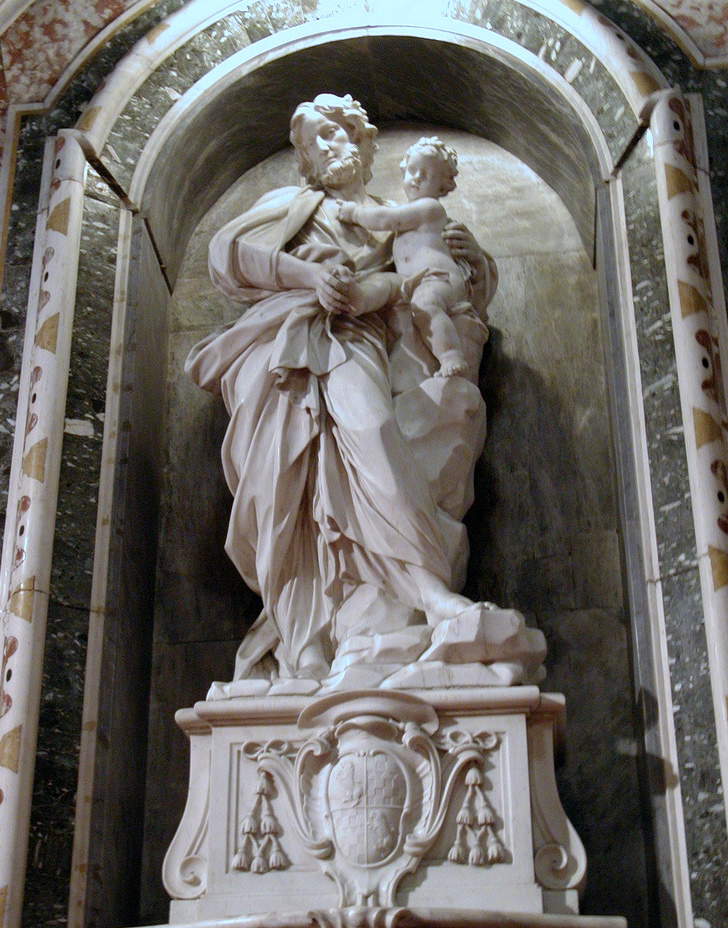 |
| 11. Giuseppe Sanmartino, Saint Joseph |
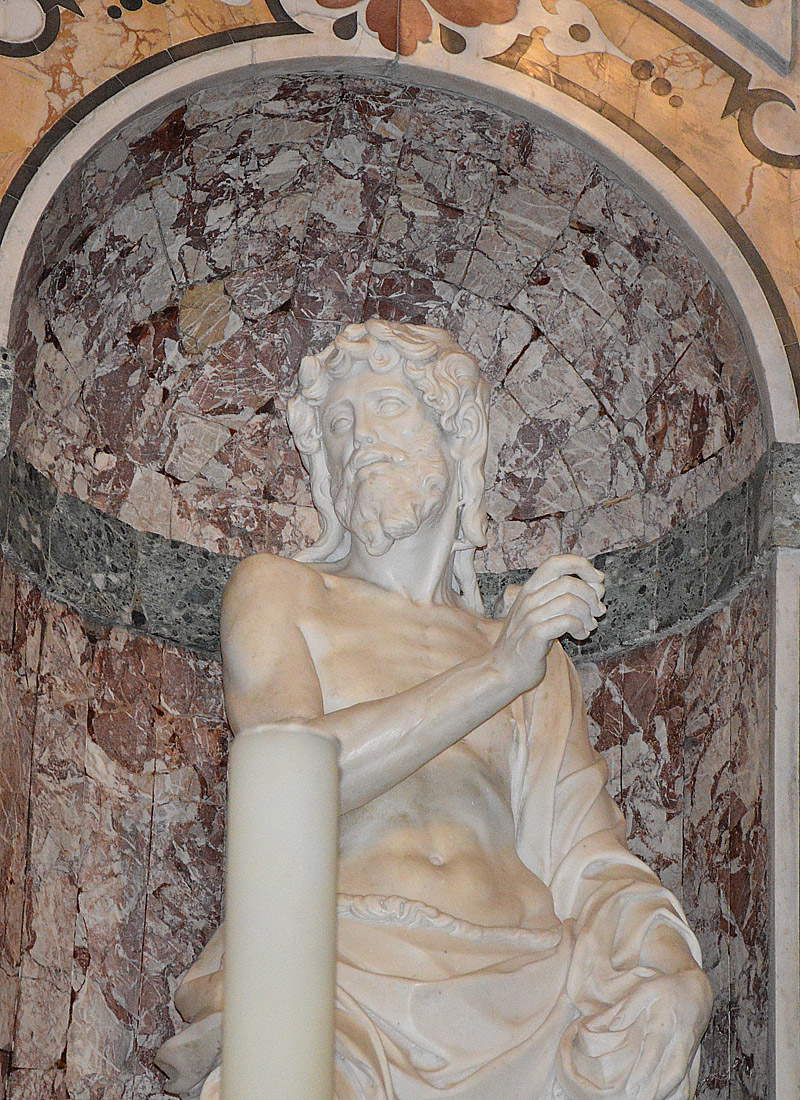 |
| 12. Giovanni Nola, Saint John the Baptist. Ph. Credit Churches on the Pilgrimage |
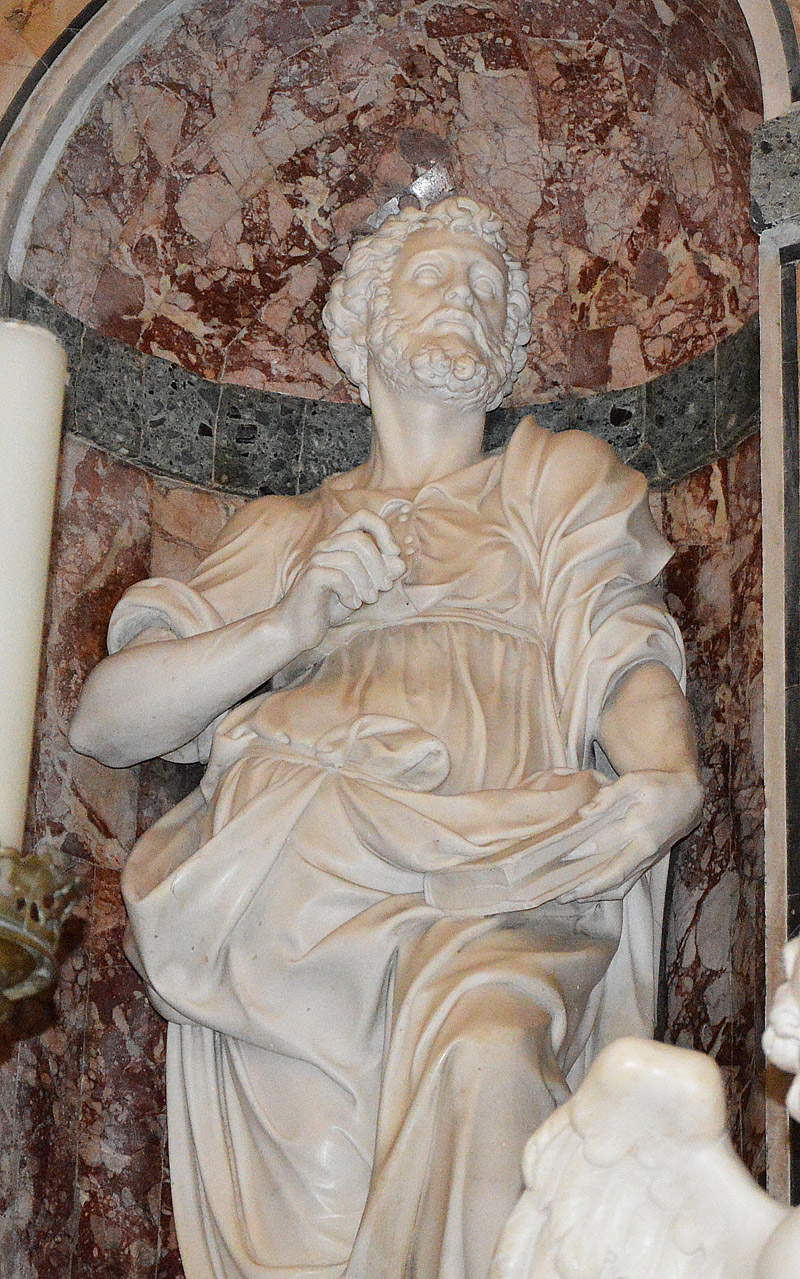 |
| 13. John Nola, St. Peter’s. Ph. Credit Churches on the Pilgrimage. |
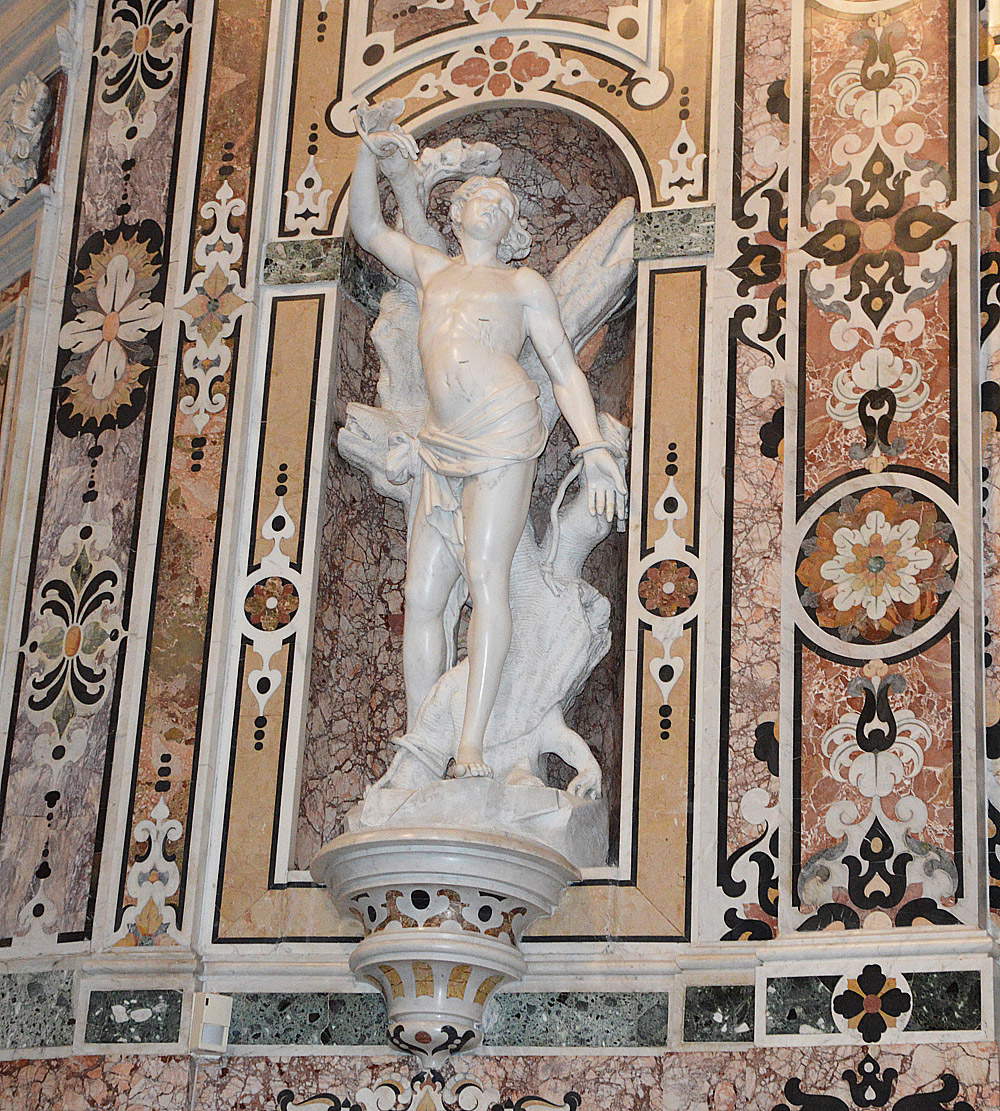 |
| 14. Giuseppe Pagano, Saint Sebastian. Ph. Credit Churches on the Pilgrimage |
In conclusion, I want to reiterate some important data concerning the figure of Giuseppe Sanmartino, who, born in 1720, took his first steps in the workshop of Domenico Antonio Vaccaro, who had inherited all the artistic sensibility of his father Lorenzo, at whom, however, another point of reference for our sculptor, the marble mason Matteo Bottigliero, had been formed. Certainly if well known are the artistic events concerning the second half of the 18th century, scarce are those relating to Sanmartino’s youthful activity, considering that the earliest known information to date dates back to 1750, the year in which he executed a clay model of St.VincenzoFerreri based on a drawing by the painter Giuseppe Bonito, while between that year and the next, in partnership with the marble worker Giovanni Cimafonte, he made two statues for the cathedral of Monopoli (Bari). Apulia is among the regions that hold the highest number of Sanmartino sculptures, from Monopoli to Martina Franca, from Taranto (I recall the Angels on the cathedral’s high altar, dated 1767), to Manduria and Ruvo di Puglia, where the cathedral houses the beautiful St. Rocco, forged in 1793 by Biagio Giordano from a design by Giuseppe Sanmartino.
Reference bibliography
Warning: the translation into English of the original Italian article was created using automatic tools. We undertake to review all articles, but we do not guarantee the total absence of inaccuracies in the translation due to the program. You can find the original by clicking on the ITA button. If you find any mistake,please contact us.